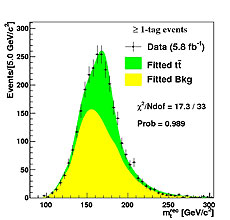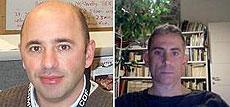|
Have a safe day!
Thursday, March 1
2:30 p.m.
Theoretical Physics Seminar - Curia II
Speaker: Jeff Fortin, University of California, San Diego
Title: Scale Without Conformal Invariance
3:30 p.m.
DIRECTOR'S COFFEE BREAK - 2nd Flr X-Over
THERE WILL BE NO ACCELERATOR PHYSICS AND TECHNOLOGY SEMINAR TODAY
4 p.m.
Joint Experiment-Theoretical Physics Seminar -
One West
Speaker: Jan Stark, LPSC, Grenoble
Title: W Mass Measurement at D0 with 5 fb-1 of Data
Friday, March 2
2 p.m.
Accelerator Controls Seminar - One West
Speaker: Andrey Petrov, Fermilab
Title: Synoptic; The Graphical Display Tool Available in the Fermilab
Accelerator Control System
3:30 p.m.
DIRECTOR'S COFFEE BREAK - 2nd Flr X-Over
4 p.m.
Joint Experiment-Theoretical Physics Seminar -
One West
Speaker: Matthew Jones, Purdue University
Title: Upsilon Polarization at CDF
Click here for NALCAL,
a weekly calendar with links to additional information.
Upcoming conferences |
|
Thursday, March 1
- Breakfast: Apple sticks
- Minnesota wild rice w/ chicken
- Tuna melt on nine grain
- Smart cusine: Italian meatloaf
- Chicken casserole
- Buffalo crispy chicken wrap
- Assorted sliced pizza
- Smart cuisine; Chicken pecan salad
Wilson Hall Cafe Menu
|
|
Friday, March 2
Dinner
Closed
Chez Leon Menu
Call x3524 to make your reservation. |
|
Joint Experiment-Theoretical Physics Seminar - today
A special Joint Experiment-Theoretical Physics Seminar will take place today at 4 p.m. in One West. Jan Stark, from LPSC, Grenoble, will give the talk, titled, "W Mass Measurement at D0 with 5 fb-1 of Data."
The lecture will also be available for viewing online.
|
Fermilab recycling numbers are up, but can still improve
Every day, Fermilab does its part to be a good steward for the environment. Fermilab staff work to reclaim natural Illinois prairie, keep the site clean, purchase sustainable equipment and more.
Fermilab also offers a well-rounded recycling program, but not everyone takes advantage of it. During 2011, Fermilab personnel recycled 133.4 metric tons of paper, glass, cans and plastic from their desksides and the cafeteria. That's only 30 percent of the waste collected - the rest went to a landfill. The laboratory has a separate recycling program for scrap metal, batteries, wood, antifreeze, toner cartridges and other small amounts of recyclable materials. That program, headed by BSS, resulted in 710.03 metric tons of material diverted from a landfill. The numbers have increased since the laboratory began its widespread recycling program, but they can still improve.
Read more
|
Fermilab calendar migration
The Core Computing Division has almost completed moving email users to the new FermiMail system. The next phase of the FermiMail project—calendar migration—is ready to begin.
FermiMail provides a single calendar service for the laboratory. Everyone with a FermiMail mailbox has a FermiMail calendar, and everyone at the laboratory can schedule meetings using a convenient web interface (email.fnal.gov) or Outlook clients available for Windows and Mac desktops. This integrated calendar has several benefits, including:
- FermiMail users need to log in just once using their services account—one less password to remember;
- A consolidated address book that provides a single way to find FermiMail users;
- An easy and widely-used meeting scheduling interface using Outlook clients or the FermiMail web interface at email.fnal.gov;
- The ability to accept, decline or counter-propose a meeting invitation in the calendar and receive email notices for each meeting;
- Supports ActiveSync-enabled mobile devices, so your calendar and email can stay in sync on your mobile devices;
- The calendar is integrated into FermiMail and uses the same high-availability infrastructure as email; both should be available through most outages and maintenance periods.
Read more
—Marcia Teckenbrock, CS
|
Fermilab event shows the fun (and funny) side of science
From the Daily Herald, Feb. 27, 2012
Longtime science teacher Lee Marek knows that it can sometimes be challenging to get young people interested in science.
Marek, a former Naperville North High School instructor who now teaches at the University of Illinois at Chicago, said that's why he cherishes the "Wonders of Science" event held at Fermilab each year.
"I love seeing all the kids out in the audience, laughing and joining in with what we're doing," Marek said. "You never know — going to one event like this might spark an interest in science that carries through into adulthood. And we certainly need more people going into the sciences in this country."
Read more
|
|
Separating wheat from chaff
 |
| The distribution of the top mass data is compared to the signal and to the background noise.
|
A peculiar characteristic of the top quark is its surprisingly heavy mass, allowing it to assume a special role in the Standard Model. The top quark mass is connected to the mass of the actively sought for Higgs boson – making a precise measurement of the top quark mass all that more important.
Tevatron collisions produce mainly quark or gluons, detected as sprays of particles called jets. Among these collisions, only about one in 10 billion produces a pair of top quarks. Each top quark decays almost immediately into a W boson and a b quark. This b quark produces a spray of particles called a b-jet. Along with the b-jet, it is the decay of the W bosons that defines the event signature, according to the number of charged leptons produced. As top quarks are produced in pairs, the signature can involve two leptons, one lepton or no leptons. The channel with no leptons at all is called all-hadronic, with six well-defined energetic jets. Unfortunately, a multijet background swamps this signature. The signal of selected jets to the background noise is approximately one in 2000.
Two years after its discovery with the more favorable leptonic signatures, CDF observed the top quark production in the all-hadronic channel and measured its mass.
Now, 15 years later, we have increased our collected data by a factor of 60. We've also applied a more sophisticated computer algorithm for the selection of events. The signal to background ratio is now one to 2.4. With these improvements, CDF has the most precise measurement of the top quark mass in this all-hadronic channel – 172.5 +/- 2.0 GeV/c2. The current CDF all-hadronic measurement contributes 14 percent to the determination of the top quark mass, and this new measurement will increase its contribution.
Learn more
—Edited by Andy Beretvas
 |
| Andrea Castro and Lucas Brigliadori, both of INFN in Bologna, Italy, were responsible for this analysis.
|
|
|